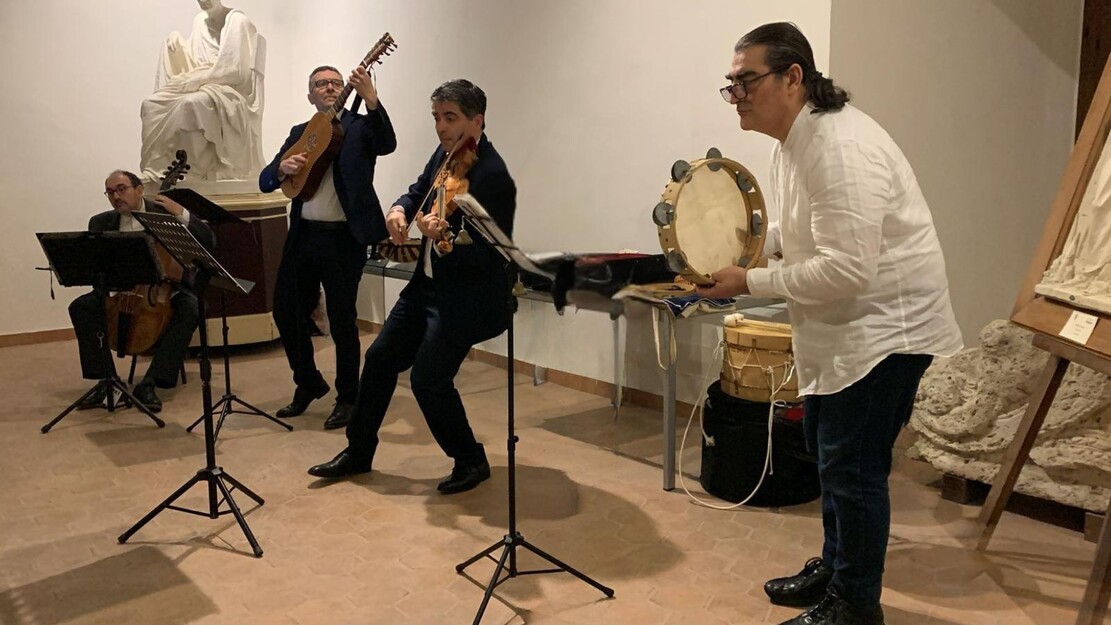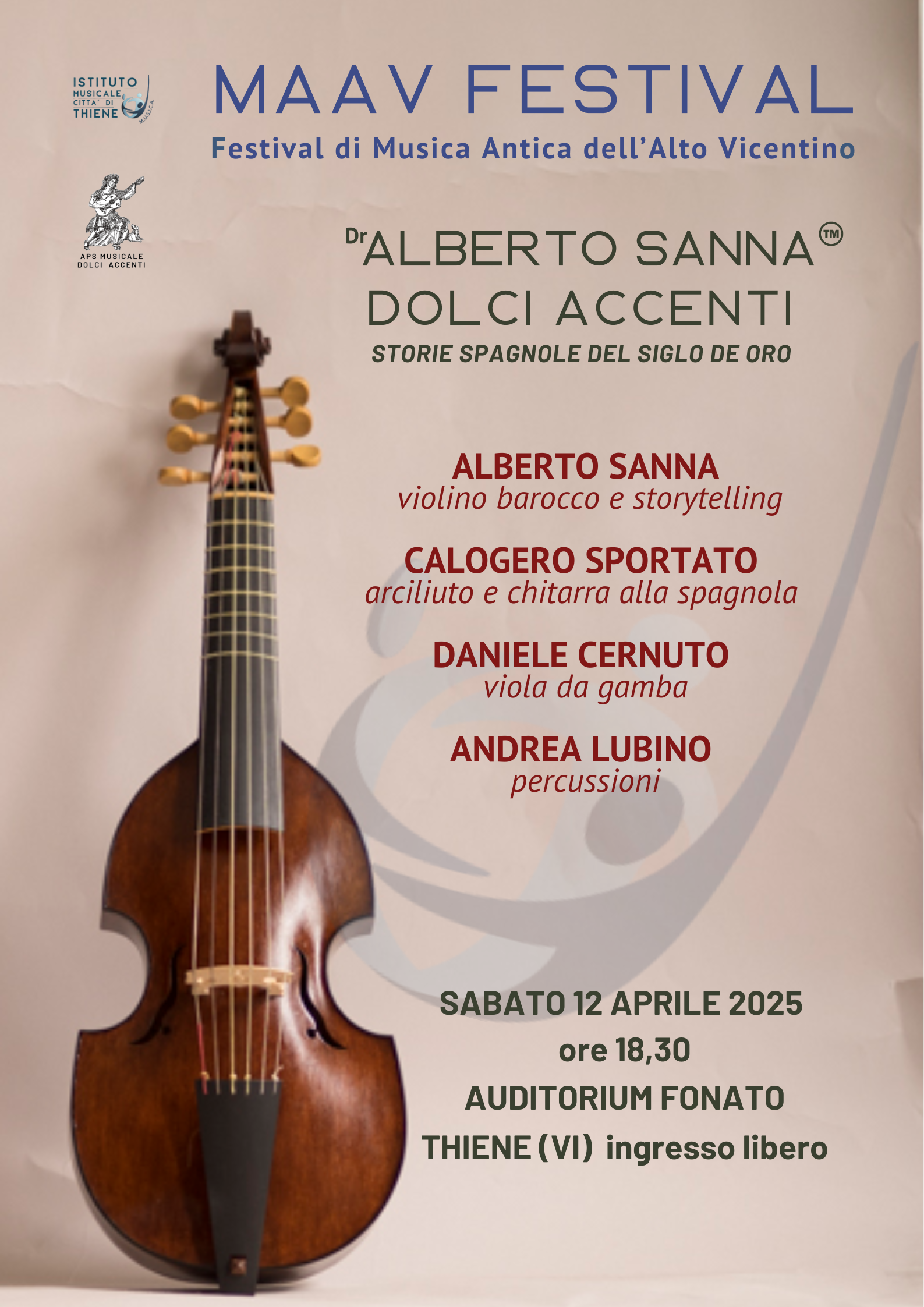MAAV Festival
12 April Italy / Thiene
The MAAV is the Early Music Festival of Alto Vicentino, organized by Istituto Musicale città di Thiene. Thiene is an ancient town north of Vicenza, rich in history and traditions.
The so-called Siglo de Oro (Golden Age) is the flourishing period of Spanish, Iberian, and Ibero-American culture between the 16th and 17th centuries, corresponding to the reigns of Philip II (1556–1598), Philip III (1598–1621), and Philip IV of Habsburg (1621–1665). These sovereigns were simultaneously Kings of Spain and the Indies, Kings of Portugal and the Algarve, Kings of Naples, Kings of Sicily, Kings of Sardinia, Dukes of Milan, and Dukes of Burgundy.
The so-called Siglo de Oro (Golden Age) is the flourishing period of Spanish, Iberian, and Ibero-American culture between the 16th and 17th centuries, corresponding to the reigns of Philip II (1556–1598), Philip III (1598–1621), and Philip IV of Habsburg (1621–1665). These sovereigns were simultaneously Kings of Spain and the Indies, Kings of Portugal and the Algarve, Kings of Naples, Kings of Sicily, Kings of Sardinia, Dukes of Milan, and Dukes of Burgundy.
The arts thrived thanks to the patronage of the courts and religious orders, and to the wealth of the cities, where precious metals from the American mines—especially in Seville—flowed in abundance. Among the most prominent figures we recall the painters Domenikos Theotokópulos, known as El Greco, and Diego de Velázquez; the writers Luís de Góngora and Miguel de Cervantes Saavedra; the playwright Lope de Vega; and the composers Tomás Luis de Victoria, Cristóbal de Morales, and Francisco Guerrero. Among the patrons, we remember Cardinal Don Juan de Tavera, Archbishop first of Santiago and later of Toledo, patron of Luis Venegas de Henestrosa.
In this musical performance, we recount the stories of the people who populated the vast lands of the Spanish Crown during the golden age of their art, literature, and music, through sounds rich in sensuality and color. These characters are women and men, nobles and commoners, poor and wealthy, clerics and laymen, and although diverse, they are, after all, not so different from us.
In the Spanish and Ibero-American Siglo de Oro we encounter abandoned lovers as well as those still waiting; the king lamenting the loss of a besieged city; the farmer torn between tending the vineyard or attending to his wife at home; and ordinary folk who, despite daily hardships, celebrate whenever they can. There are dances too fast to dance to, and songs with so many words in different languages that they end up saying nothing at all.
The most important musical source of the entire period is the Cancionero Musical de Palacio, which contains hundreds of examples of baile, canción, pastoril, romance, serranilla, and villancico, along with various genres set to religious or moral texts.
(© Dr Alberto Sanna)
© Dr Alberto Sanna – Violinist, Musicologist, and Educator
© Dr Alberto Sanna – Violinist, Musicologist, and Educator
Dr Alberto Sanna™ is a violinist, musicologist, and educator from Sardinia, specializing in Italian music from the 17th to the 19th century. His work brings together historical-theoretical reflections with practical and interpretative techniques. As a researcher, he explores the historical relationship between compositional thought and sound ideals; as a performer, he is dedicated to historically informed performance of specific genres of chamber, sacred, and theatrical music. In his publications—whether academic essays or non-commercial recordings—Alberto aims to demonstrate how early modern musicians managed the interplay between composition and performance in their creative practices.
Alberto is the creator of the concept of early music as education and the director of the Early Music Youth Orchestra™, the London String Academy, the Accademia di Musica Antica “Cristóbal Galán” in Sassari, and the “Weekend Barocchi” at the Istituto Musicale di Thiene. He is both a published author and an independent recording artist; he regularly performs chamber music and directs from the violin larger instrumental and vocal repertoires across Europe, the United States, Cuba, and Kenya.
He has taught musicology and performance at Magdalen College, Jesus College, and Lincoln College, University of Oxford, later serving as Associate Professor in Musicology and Performance, and Director of the Cornerstone Arts Festival at Liverpool Hope University. At various points in his career, he has also been a freelance orchestral violinist on period instruments, the leader of a one-to-a-part chamber ensemble specializing in Spanish Golden Age music, and an educational entrepreneur in Italy.
This versatility is reflected in his early works, ranging from a CD-ROM on the cultural and musical heritage of the Spanish Crown in the 16th century (2000), to a book on early childhood music education (2007), to an anthology disc of violin music from the late 17th and early 18th centuries (2007). More recently, Alberto has published several essays on early modern Italian music, recorded numerous albums (2010–2019), conceived and composed the soundtrack for Frank Cottrell-Boyce’s BBC Radio 4 play How to Flee from Sorrow, and authored a forthcoming book Arcangelo Corelli and the Poetics of Violin Music.
Alberto studied music at the University of Oxford (DPhil and MSt), the Longy School of Music of Bard College in Boston (MMus), and the Milan Conservatoire (BMus). He also holds a PGCE in academic practice and various other professional qualifications. He studied historical musicology with Laurence Dreyfus, Baroque violin with Phoebe Carrai and Manfredo Kraemer, modern violin with Felice Cusano and the late Zinaida Gilels.
He has won numerous awards, including a fellowship from the Academia Montis Regalis Foundation for advanced training in historical orchestral practices (1995), a visiting scholarship at the Faculty of Music and the Centre for Music and Science, University of Cambridge (2004), and an Oxford Scatcherd European Scholarship for archival research in Bologna (2008). He was also Plumer Visiting Fellow at St Anne’s College, University of Oxford (2018), and Visiting Professor at Colegio San Gerónimo, University of Havana, Cuba (2021–2023).
Dolci Accenti
Founded in 2000, the musicians of the ensemble Dolci Accenti come from diverse artistic and cultural backgrounds, meeting during their studies at the Conservatoire of Vicenza, where they specialized in the performance of 17th- and early 18th-century repertoire. Their work focuses on original sources such as treatises, printed editions, manuscripts, and chronicles of the time. Alongside their interest in instrumental music of the period, they also turned their attention to vocal music and its expressive potential.
Performing on copies of original instruments, the ensemble interprets the repertoire of one of the most fertile, varied, and rich periods in music history—not only Italian. Among their many appearances, Dolci Accenti has been invited to the Festival of Medieval Arts in Sighişoara (Romania), where they recorded for Romanian Radio, and in Vilnius (Lithuania) at the Lietuvos Musikos Akademia. Between 2002 and 2006, they were regular guests at the Monte Acuto Festival (Sardinia), and in later years performed for Amici della Musica di Milazzo, Caltanissetta, the Bellini Association in Messina, the International Festival of Bosa, Festival delle Bocche, Sonorità Riservate, Note senza tempo, Brianza Classica, Ravenna Festival, the Italian Consulate in Wolfsburg (Germany), Festival Voci d’Europa, Ente Concerti di Oristano, Nuoro Baroque Festival, Festival Internacional de Música Antiga de Caimari (Palma de Mallorca), Festival Internazionale del Val di Noto Magie Barocche, Le vie del barocco in Genoa, Musica Felix in Foggia, Festival Baroknich Umeni in the Czech Republic, Festival de Música Antigua in Zaragoza, and Les Mars Baroque Festival in Marseille.
Members of Dolci Accenti collaborate with leading Italian and international ensembles such as I Barocchisti, Radio Svizzera Italiana, Venice Baroque Orchestra, Auser Musici, and De Labyrintho, recording for labels including Tactus, Stradivarius, Glossa, Sony, Naxos, Deutsche Grammophon, K617, Arts, Bongiovanni, Dynamic, CPO, and others.
Dolci Accenti has recorded Bitte Ruhe, the complete unpublished sonatas of Fr. Ruhe for viola da gamba and basso continuo, and for Urania Records, Occhi Vaghi e leggiadri, featuring 17th-century Italian vocal and instrumental works. Most recently, they released for Brilliant Classics the Sonatas for Cello and Basso Continuo, Op. 4 by Giovanni Battista Sammartini.
Romances y glosas: «Un secolo d’oro»
Anonimo, Romance Pues no me queréis hablar
Francisco Fernández Palero, Romance Mira, Nero de Tarpeya
Gaspar Sanz, Rujero y Paradetas
Danzas bajas y alta: «Anche i ricchi ballano»
Anonimo, Canto llano El rey de España
Francisco de la Torre, Alta
Diego Ortiz, Recercada primera
Diego Ortiz, Recercada segunda
Diego Ortiz, Recercada tercera
Canciones y bailes: «La ricerca della felicità»
Anonimo, Villancico Al alva venid, buen amigo
Anonimo, Canción Niña y viña
Anonimo, Romance Paseábase el rey moro
Anonimo, Baile El villano
Juan Arañés, Chacona ¡A la vida bona!
Caricaturas: «Altre voci»
Anonimo, Canción Propiñán de Melyor
Alonso de la Plaja, Villancico La tricotea San Martín la vea
Tenores: «Tieni il tempo»
Diego Ortiz, Diferencias sobre Folía
Luis de Narváez, Diferencias sobre Guárdame las vacas
Diego Ortiz, Diferencias sobre Guárdame las vacas
Diego Ortiz, Diferencias sobre Passamezzo antico
Diego Ortiz, Diferencias sobre Passamezzo moderno
Romances y glosas: «Un secolo d’oro»
Anonimo, Romance Pues no me queréis hablar
Francisco Fernández Palero, Romance Mira, Nero de Tarpeya
Gaspar Sanz, Rujero y Paradetas
Danzas bajas y alta: «Anche i ricchi ballano»
Anonimo, Canto llano El rey de España
Francisco de la Torre, Alta
Diego Ortiz, Recercada primera
Diego Ortiz, Recercada segunda
Diego Ortiz, Recercada tercera
Canciones y bailes: «La ricerca della felicità»
Anonimo, Villancico Al alva venid, buen amigo
Anonimo, Canción Niña y viña
Anonimo, Romance Paseábase el rey moro
Anonimo, Baile El villano
Juan Arañés, Chacona ¡A la vida bona!
Caricaturas: «Altre voci»
Anonimo, Canción Propiñán de Melyor
Alonso de la Plaja, Villancico La tricotea San Martín la vea
Tenores: «Tieni il tempo»
Diego Ortiz, Diferencias sobre Folía
Luis de Narváez, Diferencias sobre Guárdame las vacas
Diego Ortiz, Diferencias sobre Guárdame las vacas
Diego Ortiz, Diferencias sobre Passamezzo antico
Diego Ortiz, Diferencias sobre Passamezzo moderno



